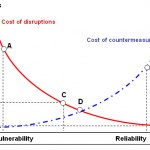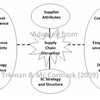 Few will question that the sender, the recipient, the freight hauler or society in general, experience additional costs when goods or persons cannot reach their destinations in time or space. Consequently, it should be obvious that a reliable transportation network represents a benefit to society. Equally, a vulnerable network would represent a net cost to society. Why then, is the reliability, or conversely, the vulnerability, of the transportation network not a matter of evaluation in traditional cost-benefit analyses?
Few will question that the sender, the recipient, the freight hauler or society in general, experience additional costs when goods or persons cannot reach their destinations in time or space. Consequently, it should be obvious that a reliable transportation network represents a benefit to society. Equally, a vulnerable network would represent a net cost to society. Why then, is the reliability, or conversely, the vulnerability, of the transportation network not a matter of evaluation in traditional cost-benefit analyses?
Samferdsel
This is an English translation of an article that was first published in Norwegian in “Samferdsel”, issue 3/2004:
Husdal, J. (2004). Pålitelighet og sårbarhet – et ikke-tema i nyttekostanalyser? Samferdsel 3/2004, s. 28-30. Reliability and vulnerability – a non-issue in cost-benefit analyses? Samferdsel (Journal of the Norwegian Institute for Transport Economics, TØI), 3/2004, pp. 28-30. (Read the original article)
Introduction
Reliability is a term that is familiar to most civil engineers and transportation planners. The reliability of a transportation network can be defined as the probability of one or more of its links either functioning or failing to function. A non-functioning, or at best badly-functioning, link will impose costs on the user in terms of loss of time, operational costs or other costs as a result of delays and diversions. Transporters of perishable goods will also experience a loss of value. These are socio-economic costs that should be taken into consideration in cost-benefit analyses of transportation projects; yet, as a norm, reliability and vulnerability are not evaluated in today’s practice. This means that the benefits or costs of existing or proposed infrastructure may be wrongly evaluated.
What is most often lacking in today’s cost-benefit analyses is a specific evaluation of the factors that can result in a non-functioning link. For a road network, this is often the result of external influences such as landslides, avalanches or rockfall, flooding, lack of snow clearing during winter, accidents that require extensive clean-up, or, as often seen in Norway, tunnel closures and failure or severe degradation of ferry services, all factors that will occur with seasonal and/or locational variations. Ferry services may be of no concern in some parts of the country, whereas rockfall can be a major issue in other parts. A study of where and to what degree such influences occur is termed a reliability analysis, or vulnerability analysis, depending on your point of view. Reliability focuses on the possibility of maintaining a link, vulnerability focuses on the possibility of disrupting or destroying a link.
Reliability needs to be more than simply a quantitative probability calculation related to the functioning or non-functioning of a link. The probability of a link being present or not, as is the case with traditional reliability engineering, does not translate into a probability of the same link being operable or not. Consequently, reliability needs to have a measure of serviceability in order to be of any value to the transportation planner or engineer. If serviceability contains a description of whether or to what extent is possible to use this link, this road, this route, this network, at a given time, then vulnerability can be defined as a measure of how susceptible this link is to a severe reduction in its serviceability. Reliability is then, as Berdica (2002) describes it, a complement to vulnerability, namely the ability to maintain adequate serviceability according to set operational parameters. A truck load of perishable goods will have different requirements towards reliability than a lorry transporting sand to a construction site. The term serviceability needs to be approached differently for different types of roads, road conditions, goods or transports. Serviceability during winter conditions is different from serviceability in summer. These factors are not accounted for in today’s cost-benefit analyses.
Vulnerability, representing the consequential costs of a lack of reliability is a quantitative term that must be included in a cost-benefit analysis. Similarly, building or construction costs to increase the reliability, or reduce the vulnerability, are also costs that need to be included. Today’s practice looks almost exclusively at the latter (construction costs), with little or no notion of reliability or vulnerability, and neglects the former.
Reliability and vulnerability in a cost-benefit perspective
The purpose of a cost-benefit analysis is to weigh the costs of a proposed project against the benefits of the project. If the benefits exceed the costs, then the project increases society’s welfare. If the costs exceed the benefits, society will experience a loss of welfare. The argument of vulnerability versus reliability is analogous: Any vulnerability of the transportation system causes disruptions that cause costs, which are in fact a loss of welfare; vulnerability is thus a cost that is quantifiable. If society puts measures in place to reduce the vulnerability of the transportation network, the increased reliability represents a benefit. The less the probability of an incident, the higher the benefits to society, and the larger the consequences of an incident, the larger the cost to society.
This can be expressed in figure 1, illustrating the relationship between vulnerability and reliability. The constructions costs, and thus reliability, increase from left to right (dotted line), disruptions costs, and thus vulnerability, increase from right to left (full line). From a strictly economical point of view, the cost of increasing the reliability should not exceed the cost of vulnerability for society to experience a benefit. What is apparent, is that it may be easy and straightforward to quantify the construction costs, the costs of disruptions are much harder to quantify in measurable terms. The construction costs are included in cost-benefit analyses, saved disruption costs are not. Consequently, a proposed investment is not valued correctly, if saved disruption costs are not properly accounted for. The question that arises is whether saved disruption costs should be taken into account similarly to saved travel costs.
Figure 1
Example 1: To keep a mountain road open during winter one may consider improving the road by building a tunnel to alleviate the most severely weather-exposed stretches, or invest in better snow-clearing equipment and increase clearing frequency. Today’s situation is (A), with high disruption costs. Building a new road and a tunnel is costly (B), but the probability of disruptions is low and the disruption costs almost negligible. Better snow-clearing equipment reduces the probability of a disruption somewhat – the road is still exposed to severe weather conditions – but the investment costs are much lower than in the former alternative. Consider which alternative is the most beneficial to society if investment costs and saved disruption cost are weighed against each other?
More reliability or less vulnerability?
In terms of emergency management, one usually distinguishes between two distinct strategies, one aimed at reducing the probability of an incident occurring and the second aimed at reducing the consequences of an incident that occurs. Applying this mindset to vulnerability and reliability, with vulnerability as the susceptibility to disruptions, one can argue that vulnerability relates to the consequences and reliability relates to the probability of an incident. Thus, a strategy to increase the reliability of a road network would be aimed at reducing the probability of a disruption, also known as pre-emptive measures, and a strategy to reduce the vulnerability of a road network would be aimed at reducing the consequences of a disruption, also known as mitigative measures.
Example 2: Heavy concrete dividers are often used on two-lane highways to reduce the probability of head-on collisions, and are seen as a traffic safety measure. At the same time they also increase reliability, by decreasing the probability of disruptions. Alternatively, widening the road shoulders without building a divider does in principle not increase reliability (head-on collisions may still occur), but it reduces vulnerability, because emergency vehicles can bypass the queueing traffic and traffic can be diverted past the incident scene easier and faster and with lesser disruptions costs (lost time) than without widened road shoulders.
Figure 2 expresses this aspect of the relationship. At an initial vulnerability V1, with a corresponding reliability R1, an investment that reduces the vulnerability from V1 to V2 at the same time increases the reliability from R1 to R2. Note that the decrease in vulnerability exceeds the increase in reliability. The opposite is the case when going from R2 to R3, where a large investment in pre-emptive measures results in a lesser reduction of the vulnerability from V2 to V3. Either way the argument is made, the key point is balancing costs and benefits, which is exactly what a cost-benefit analysis is aimed at.
Figure 2
Admittedly, this may seem like a far stray from the initial cost-benefit perspective, but it only goes to show that any investment into making the infrastructure more reliable or less vulnerable needs to balance these two attributes. An overemphasis on either side will lead to a loss of welfare for the society at large, as expressed in figure 1, and consequently, costs and benefits need to be weighed against each other.
A case study
An example from Norway may demonstrate why reliability and vulnerability should be an issue: On the North-western coast of Norway, there is a hospital in the cities of both Molde and Kristiansund, which are 75 kilometres apart. In conjuction with a recent evaluation of whether one should maintain two separate hospitals versus establishing one hospital at a new location that would cover the service areas of both hospitals, a study was conducted to compare the travel times for employees, out-patients and in-patients for a set of surrounding locations. What is disturbing to this author, and which is the reason for his interest in the subject, is that the study exclusively used “ideal” travel time parameters, among which: Speed equal to speed limit, and a waiting time of maximum 15 minutes at the required ferry crossings. What from the point of this author is lacking is a consideration of a) seasonal variations of serviceability (snowy and icy roads versus clear roads), b) the possibility of ferry breakdowns due to engine failure, ferry delays or cancellations due to high winds and rough seas (all well-known events in coastal Norway), c) potential closures of the mountain passes that must be traversed in this example (a season-dependent and location-dependent issue), d) possible closure of a subsea tunnel for certain origin-destination pairs, e) avalanches and rockfall, to name but a few. The aforementioned are all known incidents along the studied routes. However, these factors were not considered. Admittedly, incorporating these factors is difficult, and in a statistical sense maybe of no significance. Furthermore, ideal parameters are, after all, easier to use for a ceteris paribus comparison of travel times. Nevertheless, should the reliability of the transportation network not be part of the equation when locating critical public services such as hospitals? It is not the point of this author to advocate the use of worst-case scenarios; however, they should be part of the overall evaluation. If for no other reason, then such an evaluation can confirm to the public that the road network is indeed reliable or not vulnerable.
References
Berdica, K. (2002). An introduction to road vulnerability: what has been done, is done and should be done Transport Policy, 9 (2), 117-127 DOI: 10.1016/S0967-070X(02)00011-2
Related
- husdal.com: The reliability and vulnerability of transportation lifelines
- husdal.com: Reliability and vulnerability versus costs and benefits (INSTR2004)
- husdal.com: Reliability and vulnerability versus costs and benefits (ETC2004)
- husdal.com: The reliability and vulnerability of road networks in a cost-benefit perspective
- husdal.com: Transport Network Vulnerability – which metrics should we use?
- husdal.com: Are roads more important than computers?














